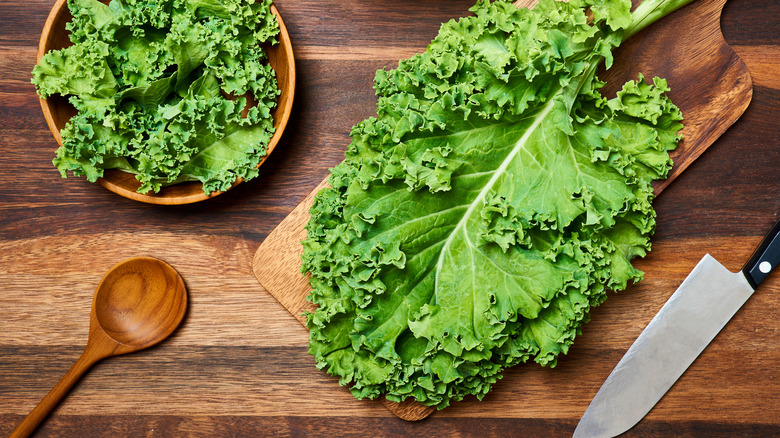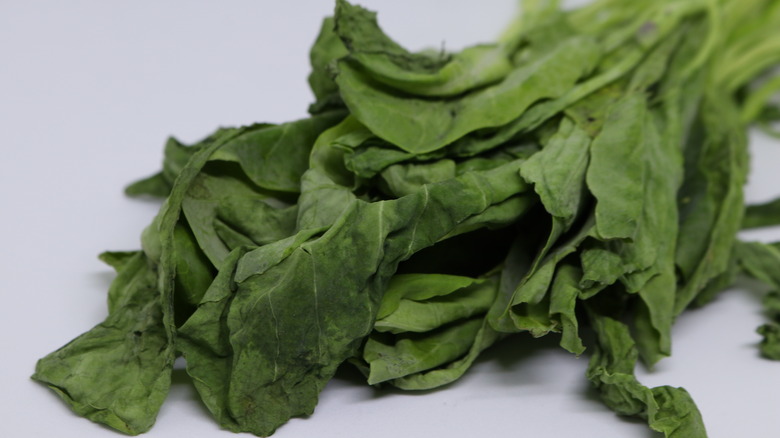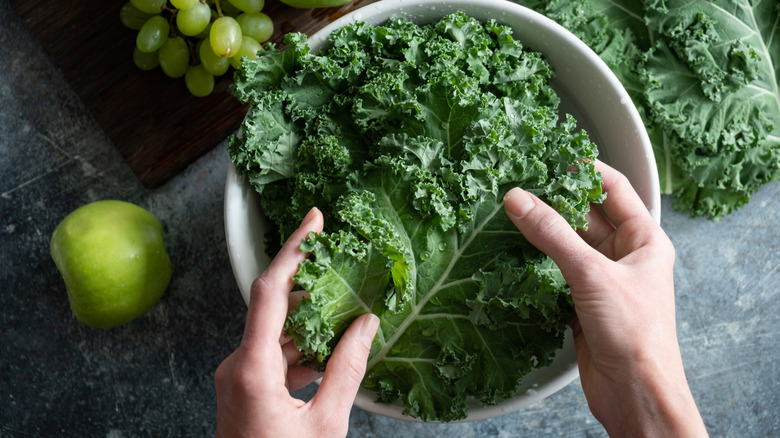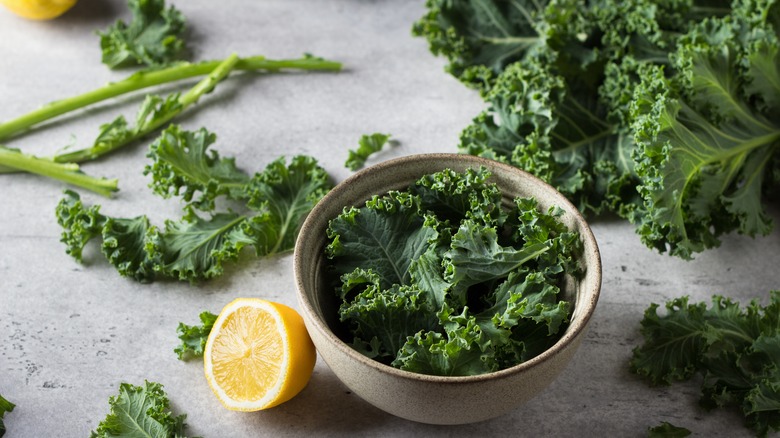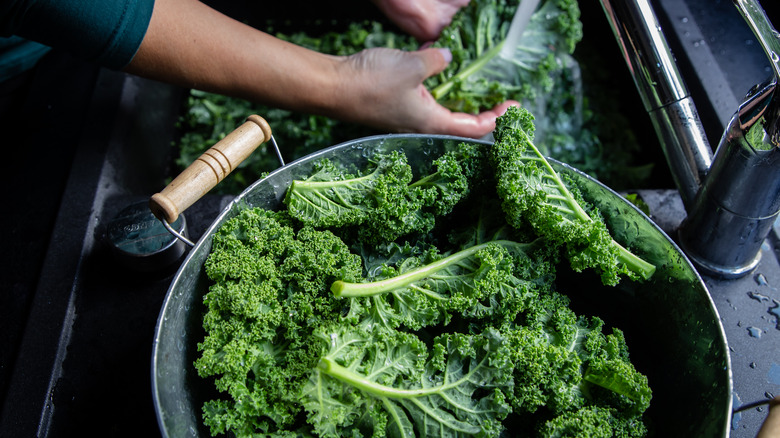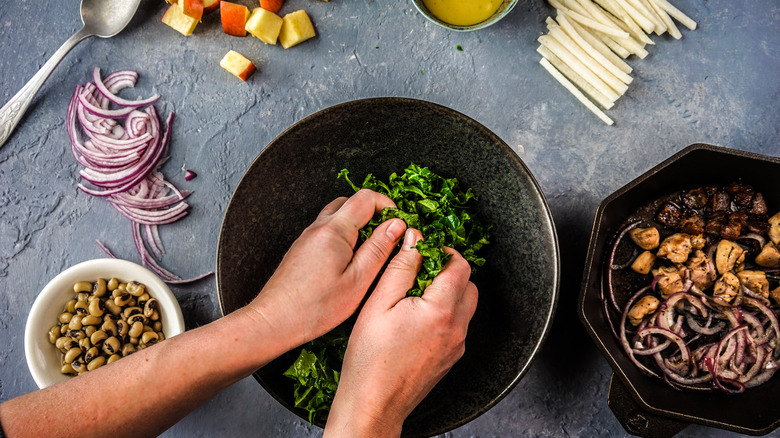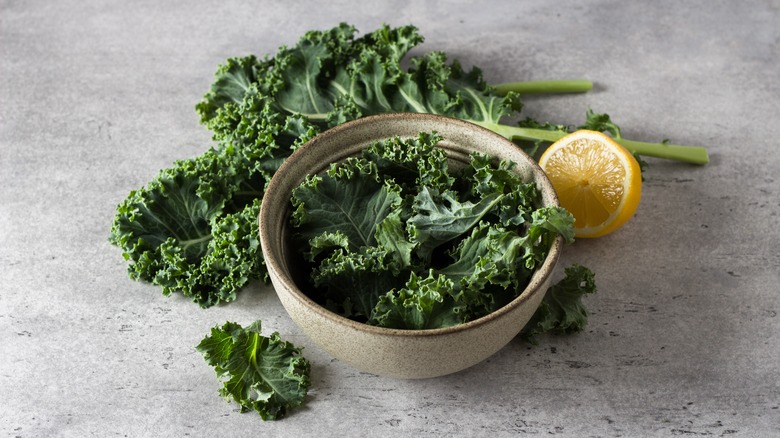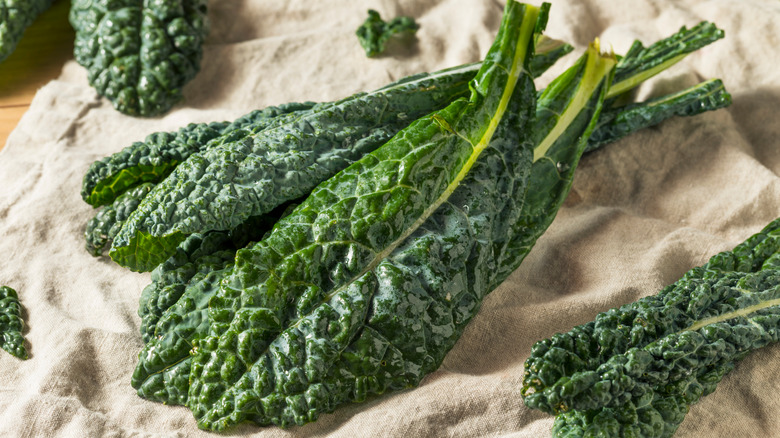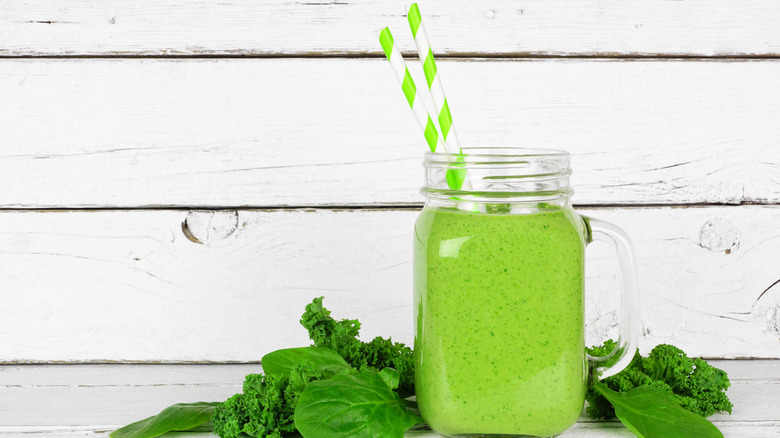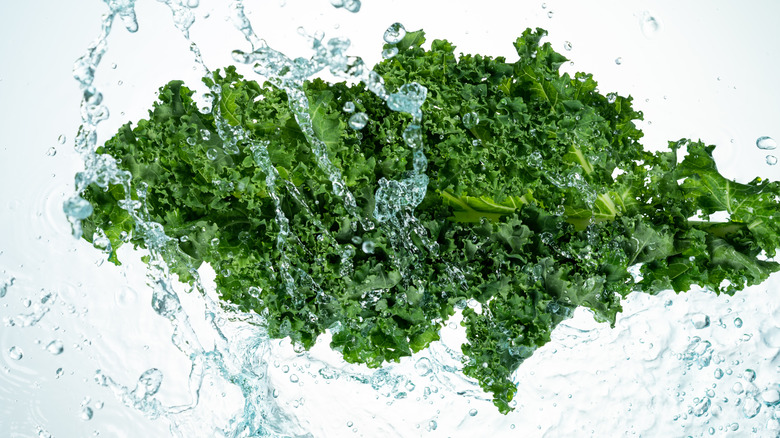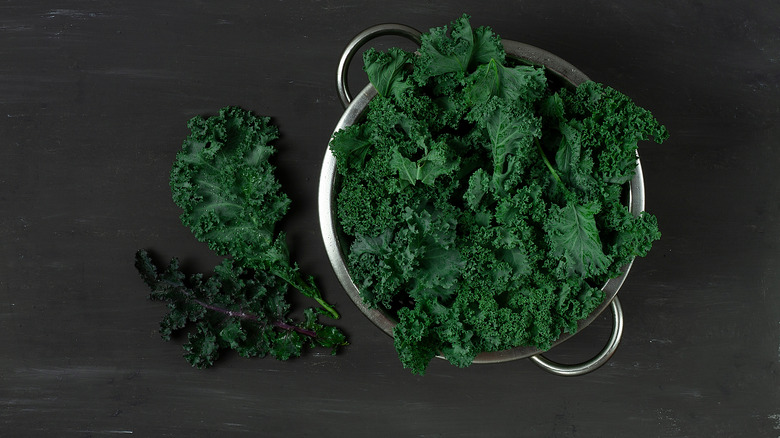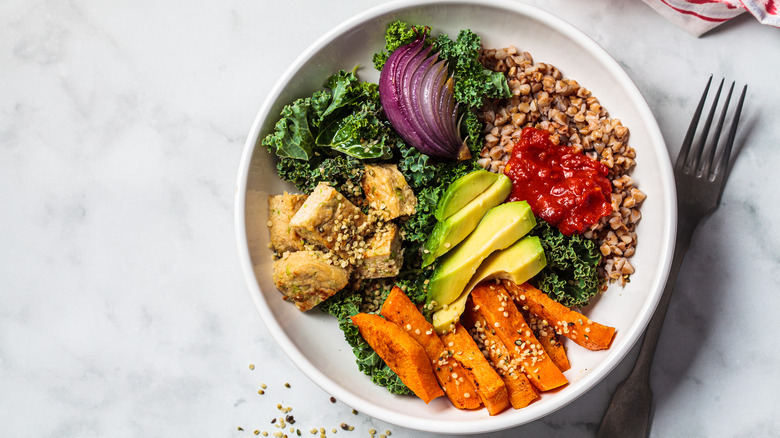Mistakes You Need To Avoid With Kale
People love to hate (and hate to love) kale. Prior to 2012, the notoriously bitter and difficult to chew leafy green was primarily just used to decorate Pizza Hut's salad bar (via NPR). So what changed over the past decade? One major factor is that people began to realize that it is one of the most nutrient-packed vegetables out there. Just 1 cup of kale contains 206% of the recommended dose of vitamin A, 134% of vitamin C, and a whopping 684% of vitamin K. It is also high in antioxidants, calcium, and magnesium. Studies have even shown it to help lower cholesterol. Given the benefits, kale is unsurprisingly dominating the health food market.
Yet, it can still be hard to get past kale's tough texture and taste, making it a vegetable a lot of people claim to not enjoy. However, you do not have to eat kale begrudgingly. If you avoid these mistakes, you get the full satisfaction of a food that has the potential to taste great in addition to being great for you.
Buying wilted greens
The trick to getting the most out of kale begins in the grocery store. Generally, if you're shopping at the supermarket, it's hard to know how long ago the produce was picked, but there are ways to judge for freshness. For top-quality kale, make sure to keep an eye out for bunches with hearty dark green leaves and strong stems, which are good indicators that your purchase will last a few days once you take it home.
Signs that kale has sat on the shelf for too long include limp, yellowish or brown leaves and a strong odor. If the bunch is already wilting, it will not be enjoyable and is certain to continue deteriorating once you bring it home. Try to avoid kale that has holes in the leaves as that is a sign that pests have been crawling around and feasting on the greens (via Gardenary).
Washing kale before storing
Once you have picked out a quality bunch of kale, you want to store it properly. Because this is a sturdy vegetable, it will generally keep longer than greens like spinach; however, some care is needed to elongate its shelf life. Your gut reaction may be to wash your greens as soon as you get home. However, this extra moisture can speed up spoilage. The best way to keep kale fresh is by drying it before storing the leaves; you only want to wash it right before you plan to use it.
When you arrive home with your kale, pat the leaves with a paper towel to remove excess water. Then wrap it in paper towels and place the bunch in a bag to store in the fridge (preferably towards the back or in the crisper). Once dry, your kale should hold up in the fridge for three to five days. If you don't think you'll be able to use it before then, consider freezing the leaves.
Not removing the stem
Kale has a fibrous stem that is hard to chew, but thankfully it's easy to avoid the unpleasant sensation of chomping down on a tree branch. The fastest way to destem kale starts with holding the bottom of the stem in one hand to stabilize it. Then in one swift motion, use your other hand to rip the leaves away from you. By using this method, you can enjoy stem-free kale in no time.
While those stems are unappetizing in their raw state, there are a few ways to make them palatable. The Organic Place recommends pickling them in a brine of water, apple cider vinegar, sugar, salt, and spices. (These are best if you wait a week before eating.) You can also make sweet and spicy kale stems by sautéing them with onion and dressing them with honey, soy sauce, and sriracha (via The Endless Meal). Other options include turning the stems into a pesto or even making a crunchy salad out of them (via Compost Collective KC). Whatever you choose to do with them, Compost Collective KC suggests blanching the stems for 2 minutes in boiling water to release some of their bitterness.
Not washing your kale properly
Leafy greens like kale can collect a lot of dirt and debris. If you do not wash them thoroughly, you may get a mouthful of unpleasant grit. After you take the stems out, chop the leaves and wash them in cold water. Note that chopping the leaves damages the cell walls and in turn releases some of the bitter compounds. But by doing this before you wash them, you can rinse away some of the acrid taste.
Soaking kale in ice water after washing is another way to take down the astringency level. This trick can also help revive your greens if they have started to wilt. After a good soak, drain the kale in a colander. If there is any remaining dirt in the leaves, you want it to escape with the water. For best results, dry the kale out in a salad spinner before use. This should leave the greens nice and crisp.
Not massaging the leaves
Another way to transform your kale is by treating the leaves to a spa day of sorts. The Food Network's Sunny Anderson praises massaging kale as a way to make it easier to chew and digest. In a December 2021 tweet, Anderson recommends putting the leaves in a bowl, then squeezing and tossing them a few times with your hands. She also likes to incorperate fresh lemon and orange juice, but notes that a citrus addition is not necessary.
Try applying this technique to our Mexican kale salad recipe. Cut the leaves into thin strips and place them in a large bowl. Massage 1 teaspoon of olive oil and a quarter of a teaspoon of salt into the greens. Then add red pepper, black beans, corn, tomatoes, jalapeno, cilantro, avocado, and red onion to the mix. Toss the salad with a dressing of olive oil, lime, crushed garlic, honey, cumin, and salt, and top with toasted pepitas.
Skipping the acid
Combining the tang of buttermilk and zest from herbs and spices, ranch dressing is an American favorite for a reason. This full-bodied dressing, however, may put a damper on your kale salad. As a bitter green, kale screams for acid. Not only does a spritz of lemon or a similar accompaniment help to balance out the flavors, but it can soften the leaves, in addition to or in place of massaging, making them easier to chew (via It's A Veg World After All). A creamy dressing like ranch will not bring out the best of this vegetable.
Instead, opt for a kale salad such as Michael Solomonov's kale, apple, and walnut tabbouleh recipe. This salad of shredded kale, walnuts, honey crisp apple, and pomegranate seeds is dressed with fresh lemon juice and olive oil. It is also accompanied by another acidic ingredient, pickled sumac onions. The bright acidic notes will help cut through the bitterness.
Sticking to one type of kale
Most people are familiar with curly kale. Sporting bright green leaves with curled edges, this is the most popular kale variety you'll find in the supermarket. However, there are numerous different types of kale. If you are just buying the green, curly kind, you are missing out on everything else this vegetable has to offer.
Lacinato, which goes by several names including Tuscan (it's native to Italy), dinosaur, and cavolo nero, should be on your radar. With longer, darker, and softer leaves and more tender stems, you can skip some of the extra steps in preparing this variety — simply thinly slice and dress after washing.
Another type of kale worth trying is Red Winter. It can anchor a vibrant salad without all the extra chewing, thanks to its reddish-purple stems and tender, sweet green leaves. Baby kale is also a great choice for salads. These young-picked leaves have yet to develop their bitterness, and they are known to have a slight peppery flavor. If you are going to cook baby kale, these tender leaves will act more like spinach and will wilt down very quickly.
Using kale only for salads
Promoted as a superfood, kale salads are all the rage, but you are missing out if you only eat the leaves raw. In our recipe for spicy kale with fried grapes and frizzled red onions, you can experience how good kale tastes when sautéed. Because kale is a hearty green, it can also withstand braising without losing its character. In our farro with sweet potatoes, braised kale, and celery root recipe, the leaves benefit from a dip in chicken stock along with celery root, onion, garlic, and bay leaf.
Hungry for a snack? crispy kale chips are easy to prepare in the oven or air fryer. Kale also makes a nutritious addition to any smoothie. Try Jared Van Camp's green morning smoothie recipe. which blends the greens together with cucumber juice, ginger, lemon, celery, avocado, parsley, chard, and crushed ice for a refreshing drink.
Not blanching before freezing
Even though kale can last longer than many greens, you may still want to freeze it to keep it at its freshest state, especially if want to cook with it later. However, you shouldn't just freeze raw kale. Generally, you should blanch leafy greens before freezing them. If you do not do this, you may end up with discolored or mushy leaves. Blanching is the best way to preserve the texture, flavor, and color of kale. It will also take up less room in your freezer, as the greens will shrink in volume.
To blanch kale, bring a pot of boiling water to a boil, then drop leaves into the pot and boil for 2 minutes (via Frugal Hausfrau). If you're also including the stems, Walk to Eat recommends adding them to the water a minute before the leaves. Transfer the greens to a bowl of ice water to halt the cooking process. Drain the cooled leaves and prepare for freezing or immediate use. Blanching can be another way to make it more manageable to eat before other preparations such as sautéing.
Not pressing water out of blanched kale
Whether you're blanching kale to freeze or just to eat immediately, there is an important step you do not want to miss. After you drain the cooled greens in a colander, you must get out as much of the excess water as possible (via Frugal Hausfrau). Freezing vegetables causes them to retain a lot of moisture, so you can help prevent ending up with soggy greens by wringing them out.
Take your hands and squeeze the leaves to draw out the water. Frugal Hausfrau also recommends putting them through a salad spinner if you have one. If not, you can spread the kale out on a clean kitchen towel to pat dry. Place the greens in plastic bags and push out as much air as possible before storing them in the freezer. When handled properly, blanched kale can keep frozen for up to a year. To defrost, place the bag of kale in a bowl of cool water until it has thawed, although you do not need to defrost when using it for smoothies (via A Clean Bake).
Not pairing with other flavors
Using citrus and massaging the leaves are two ways to make kale more palatable by itself, but perhaps the best way to truly enjoy the green is to combine it with other foods. Create a dish that matches your personal flavor profile. According to The Devil Wears Salad, kale pairs well with fruits like apples and peaches or other vegetables like carrots and radishes. It's also a good fit with ingredients like chickpeas, cheese, and mustard.
Our kale slaw recipe combines the vegetable with peppery purple cabbage and sweet carrots, all tossed with a tangy dressing of Greek yogurt, olive oil, mustard, and apple cider vinegar. For a heartier dish, we recommend our Portuguese kale soup recipe. The greens are simmered in a chicken broth with garlic, potatoes, and chorizo for a flavorful bowl of goodness. If you love cheese, give our kale lasagna recipe a try. The addition of the greens takes the Italian classic to a whole new level.
